Iain Treloar looks at the most fiercely contested pricepoint in the road bike market, testing five road bikes below $2,000.
Photography by Thomas Joynt.
It’s incredibly easy, and tempting, to drop a serious wad of cash on a road bike, and most road riders—current, future or potential—are accustomed to the shock value of an expensive price-tag. With the starting point of around $1,000 from major manufacturers, even the most basic road bike represents a sizeable investment.
There’s a reason for the relative costliness of road bikes, of course; there’s a higher premium placed on light weight, leading to more expensive manufacturing processes, and the components are more expensive as well.
The $1,500 to $2,000 bracket is arguably the most fiercely contested pricepoint in the road bike market. At that price, you’re starting to get decent componentry like Shimano’s 105 groupset (and occasionally, even Ultegra); you may also get some choice in frame material, with carbon fibre sneaking into the mix alongside aluminium. It’s the level where road bikes shift from being purely recreational to something a little more serious.
Although bikes in this financial ballpark have traditionally tended towards accessible ‘endurance’ positioning, this is beginning to change; there are now racier options available if you’d rather something with a little added zip.
The other big trend of the past couple of years is the growing popularity of disc brakes. These are increasingly appearing on endurance road bikes—not so much race bikes—and it appears likely that they’ll soon be just as ubiquitous on-road as off. Given their development is still fairly recent, there’s not yet a hydraulic disc braking option available on bikes below $2,000. Unfortunate, yes, but until the technology trickles down to a more accessible level, most mechanical disc brakes do a decent job of pulling you up, with particular gains in braking performance to be discovered in the wet.
Across the five bikes we’ve reviewed here, there’s a fairly broad assortment. It’s not a strict side-by-side comparison, with too much variation in the style of the bikes to draw strict parallels. What it is, however, is an overview of five of the best (or most interesting) road bikes that you can get for under $2,000.
Cannondale Synapse 105 5 Disc
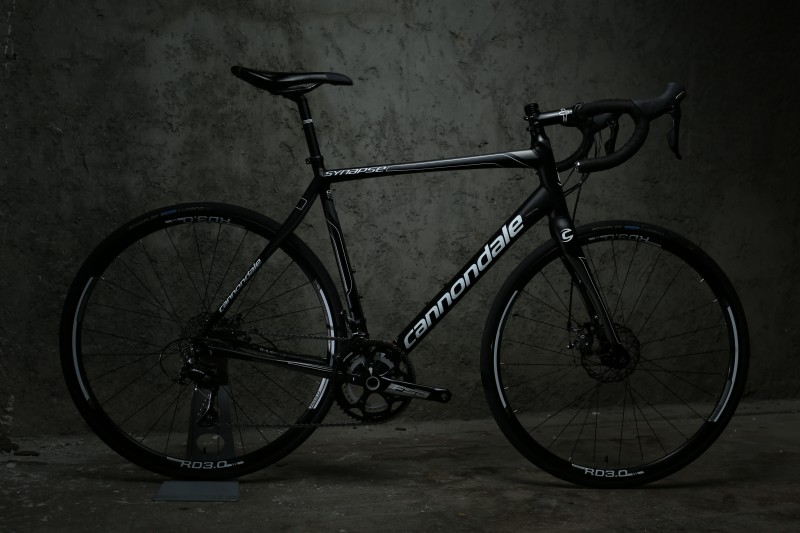
Cannondale have a long and distinguished history in the road market, with aluminium frames in particular. With their CAAD10 race model, they were almost single-handedly responsible for changing the perception of what an aluminium frame could be, triggering the re-emergence of aluminium as a valid high-end frame material. They’ve had success with their Synapse endurance model as well; its carbon variant is one of the better regarded road bikes of recent years.
The alloy disc model, which we tested here, aptly demonstrates Cannondale’s experience with aluminium. In a stealthy matte black, it’s attractive, with smoothly executed welds and a high quality overall finish.
The Synapse position is quite upright, with a lengthy head tube (almost 19cm in our 56cm review bike) helping reduce back discomfort on long rides. Further comfort is found through the frame’s manipulation of aluminium; the seat-stays, changing planes like a helix on their path to the top-tube, do an effective job at easing perceived vibration, and a small diameter (25.4mm) seatpost offers additional flex, reducing sting through the saddle. An alloy-steerer carbon fork at the front completes a comfortable frameset.
The Synapse is stable rather than twitchy, offering an accessible ride quality. It handles particularly well on descents, tracking predictably and inspiring confidence to take corners faster than usual. It’s less stunning as a climber; at 9.65kg it’s not overly light, and feels hindered by this, especially out of the saddle. Sensibly, Cannondale have opted to spec a generous gear range on this model—a compact crankset, and up to 32t on the cassette—which means that you’re able to spin up the steeper stuff with relative ease, even if the frame doesn’t particularly encourage attacking riding.
The Shimano 105 groupset provided on this bike was predictably good; I’m a fan of the new lever shape, and the shifting is smooth and reliable. Less impressive was the bike’s braking. To provide some context, I should say that I’m an unabashed believer in disc brakes on road bikes. They should—and usually do—offer better braking in a wide range of applications, and provide a tangible benefit compared to a conventional road caliper.
This wasn’t the case on the Synapse, which suffered from exceptionally heavy brake-feel, especially at the rear. This is likely in part due to the internally routed cabling and full-length cable housing, both adding resistance to the point that braking was a whole hand exercise, and completely exhausting on long descents. Not only was the feel through the lever too heavy, but the brakes felt distinctly underpowered. I’ve previously owned (and really liked) a non-disc alloy Synapse, so I can speak from experience in saying that the disc brakes on this model did not improve it.
That said, the frame of the Synapse is still lovely and smooth and the components selected are generally well considered; it’s a versatile bike with broad appeal, but be prepared for some frustration or additional expense along the way to get the stopping power up to scratch.
Specs
Frame 6061 aluminium, SAVE PLUS, BB30
Fork SAVE Disc, carbon blades, 1 1/8”
Gearing Shimano 105 11 speed
Brakes Promax Render R, rotors 160mm F/140mm rear
Wheels Maddux RD 3.0 Disc, Formula disc hubs
Tyres Schwalbe Lugano 700x25C
Sizes 48, 51, 54, 56, 58, 61cm
RRP $1,599
81%
Function 32/40
Quality 33/40
Price 8/10
Appearance 8/10
Apollo Giro Disc Hi-Viz
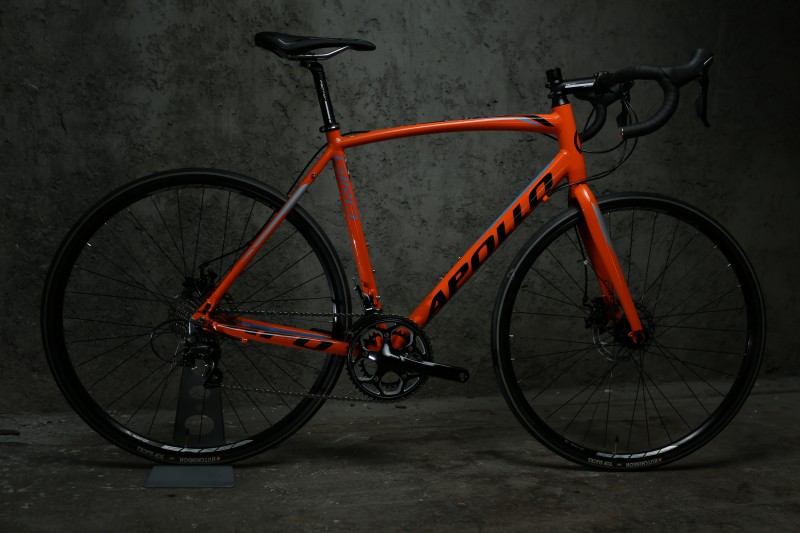
Apollo has a long history in Australia, having worked hard to improve their perception in the road market. At the same time, they’ve broadened their range of commuting bikes, introducing models like the belt-drive, flat-bar Trace 45 recently reviewed in Ride On.
In all their joyous colour, that bike and this are right on trend, and with reflective decals on the seat stays and fork blades they stand-out in low light conditions as well.
The Giro Disc, aluminium throughout (including the fork), is somewhat unusual as a road bike leaning toward commuting practicality rather than open-road speed. In its choice of material, it’s built to handle a few knocks. It’s also unique of the five bikes here in having the provision for both mudguards and a rear rack.
Like the Cannondale Synapse, the Giro opts for mechanical disc brakes front and rear. The brake-feel on the Apollo is substantially better; the cable is routed externally down the seat-stay (where the Cannondale is internal, through the non-drive chainstay). The difference is vast; this is what mechanical disc brakes should feel like, and their presence on the Apollo is appreciated, providing consistent braking in wet weather and dry.
The geometry of the frame, on paper, is fairly par for the course. In practice, it’s a different story. It’s taller at the front end than its 18cm headtube would suggest; indeed, despite this measurement being a centimetre less than the Synapse, the Synapse actually has a lower front end (there’s a stack of mudguard and tyre clearance in the Apollo’s fork that throws these dimensions to the wind). Encumbered so by its relaxed position, the Giro is not a bike that feels particularly lively; it’s harsher than the Synapse but rather long and bulky, trundling along without any particular sense of urgency.
This isn’t helped by the bike’s weight, an unimpressive 11.23kg—more than 1.5kg heavier than the Synapse, and a whopping 3.5kg more than the Cell. Weight’s not the be-all and end-all of a bike, of course, but these are big differences, and certainly discernible in everyday riding.
However, there’s something almost admirable about the design ethos that produces a bike like this. The Giro doesn’t try to compete on weight or speed, but more than any other of these bikes it is an honest all-rounder. It’s equipped with reflective-sidewall 700x32c tyres, but you’d be able to fit wider, and probably still some mudguards as well. The wheels are tough, with broad Sun Ringlé rims. Paired with that no-nonsense but bulky frame, I’d have confidence taking this on some serious gravel, or touring, or beating it up as a daily commuter, even if I think I’d somewhat resent its lumbering character as a pure road bike.
Specs
Frame Triple butted 6061 aluminium
Fork Aluminium, 1 1/8” steerer
Gearing Shimano 105 11 speed
Brakes Hayes CX Comp mechanical disc, 160mm rotors
Wheels Sun Ringle SR25 alloy, disc hubs
Tyres Hutchinson Top Slick2 700x32C
Sizes S, M, M/L, L, XL
RRP $1,599
80%
Function 31/40
Quality 33/40
Price 8/10
Appearance 8/10
Cell Omeo 1.0
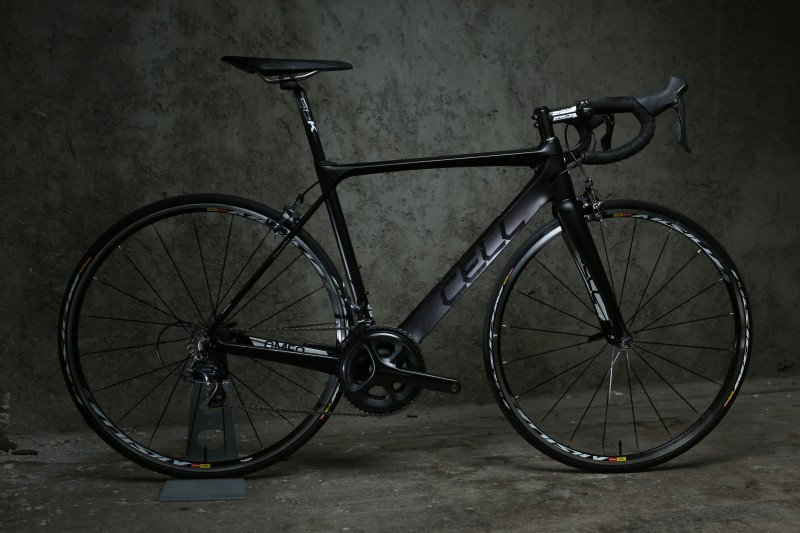
Sydney-based Cell have had a big year, launching some terrific, reasonably priced machines. We tested their cyclocross bike, the Brunswick, last issue and found it to be one of the stand-outs of 2014. The Cell Omeo 1.0, however, is arguably the bike that kick-started the brand’s renaissance.
Designed in Australia and built in Taiwan, the Omeo is 7.7kg of stealth and speed. You’ll note that it’s the only one of the five tested here to come with Shimano’s excellent second-tier Ultegra groupset, and along with finishing kit from FSA and reasonable wheels, its value for money is second to none. It’s also a speedy-looking (and feeling) bike, although it’s difficult to draw any firm conclusions about its touted aerodynamic credentials in the absence of wind tunnel data.
The Omeo is a bit of an anomaly for the price-point in its aggressive geometry. It doesn’t pretend to be anything other than a race bike; with a semi-compact frame design and a mere 14cm of head-tube in the M/L frame size tested, the position isn’t suitable for everyone, leaning more towards racers on a budget than first time road riders. It feels deceptively small; at first I thought I needed a size up but after a few rides I came to enjoy the lithe, agile nature of the bike, as facilitated by its dimensions. The Omeo isn’t a longsword; it’s a dagger.
The componentry selected further highlights the Omeo’s racey ambitions. The Fizik Arione saddle is long and narrow, suiting riders with good flexibility, whilst a carbon bar and stem aren’t normal inclusions on a beginner’s road bike; further still demonstration of the bike’s value. Gearing throughout is 11 speed Ultegra; the Omeo uses a mid-compact crankset (52/36t) with a closely spaced 11-25t cassette. Personally I’d prefer ratios a little lower, but the stiffness of the frame ensures that little of the effort you’re putting through the pedals goes to waste.
What goes up must come down, and the sharp handling of the Omeo makes descending a pleasure. It encourages you to rip into corners, take daring lines and push the limits, and because it’s such a playful, nimble little thing, it’s easy to throw around.
The frame does a relatively good job of dealing with vibration, helped by the selection of 25c tyres and carbon contact points. As such, the overall ride-feel is far smoother than you might anticipate.
The Omeo is a dead-set winner, and astoundingly good for the price. That said, it’s a very particular bike for a very particular type of rider; It’s excellent at what it does, but it’s far from universal in its practical appeal. Be realistic about what you’re looking for in a road bike and whether this is it. If it is, great—you’re going to have an awful lot of fun.
Specs
Frame Full carbon
Fork Full carbon, tapered steerer
Gearing Shimano Ultegra 11 speed
Brakes Shimano Ultegra road caliper
Wheels Mavic Aksium
Tyres Mavic Aksion S 700x25C
Sizes S, M, M/L, L, XL
RRP $1,999
86%
Function 34/40
Quality 34/40
Price 10/10
Appearance 8/10
Felt F75
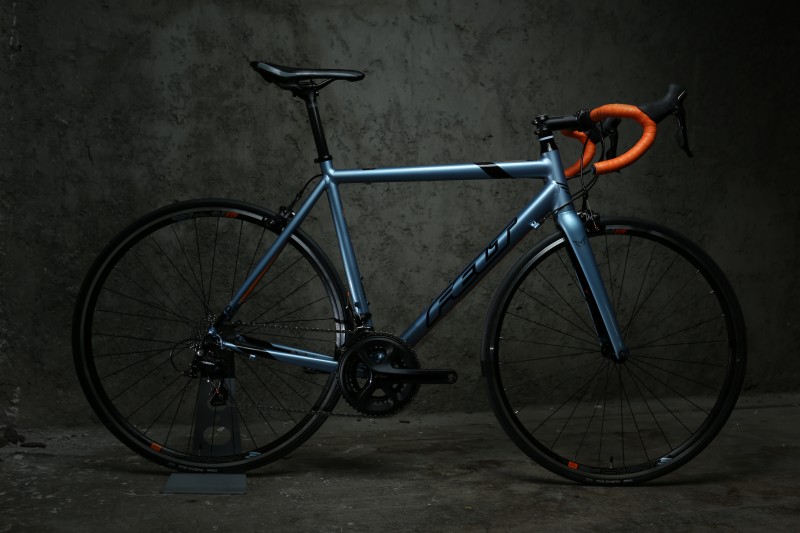
American brand Felt is probably best known for their sponsorship of Argos Shimano a couple of years back, and even if their bikes are no longer ridden in the World Tour, their strong reputation perseveres. The F75 is their top of the range aluminium model, with an almost identical geometry to the pro-level F-FRD carbon thoroughbred.
As you might expect, that’s a pretty sorted geometry. The dimensions of the bike felt comfortable quite quickly, and with a less aggressive drop than the Cell Omeo it was a little easier on the lower back. Because it has a race geometry, it’s another one of those bikes that seems to urge you on to greater speed, rather than allowing you to coast; it was on the F75 that I notched up a whole host of Strava personal bests on my most regularly used training route.
That speedy side, unfortunately, has a downside. The frame is very harsh, transferring a whole lot of feedback through the seat and the hands; we’ve seen aluminium worked in such a way that it can be comfortable, but this was not the case on the Felt.
The battering was exaggerated by the saddle supplied, a perennially uncomfortable model without a single comfortable place to sit, no matter how the angle was tweaked.
The componentry throughout was otherwise generally of a good standard. Shimano 105 gearing kept things running smoothly; the unbranded brakeset looked cheap, but was surprisingly powerful, taking care of stopping duties with aplomb.
The elegant-looking fork was also of an impressive quality, featuring a carbon steerer and carbon drop-outs—both rare inclusions at this price. It did a reasonably good job at handling road chatter, but it was overwhelmed by the frame’s lack of subtlety and in light of such was always going to face a bit of an uphill battle. The wheels were reasonable—and tubeless-compatible—but the braking surface wasn’t finished off as well as might be hoped, with a fairly obvious join perceptible under hard braking.
Despite these gripes—and note that the ride quality may not even be a problem for you, depending on what you prefer in a bike—the Felt had its charms. It’s a tasteful looking machine, easily my favourite of the five; I don’t know why more companies don’t use ice blue and orange as a colour scheme for bikes. It’s also been finished off really nicely, with orange cable ends and ferrules and a matching carbon stem cap and anodised blue stem cap bolt. This is the kind of attention to detail that you only find in a company that cares about what it’s doing. Even if it’s not the most comfortable bike in the world, it’s at the very least a likeable one.
Specs
Frame SuperLite aluminium, tig-welded
Fork UHC Advanced Carbon Fibre, tapered steerer
Gearing Shimano 105 11 speed
Brakes Road caliper
Wheels Felt RSL3, tubeless ready
Tyres Vittoria Rubino Slick 700x23C
Sizes 48, 51, 54, 56, 58, 61cm
RRP $1,899
81%
Function 34/40
Quality 31/40
Price 7/10
Appearance 9/10
Merida Scultura 4000
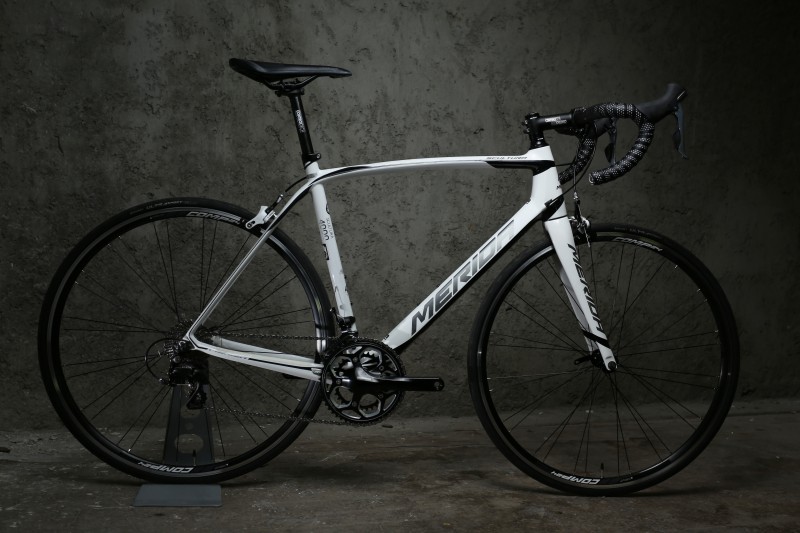
Merida are one of the great success stories of the Taiwanese cycling industry, with annual production well into the millions, and as 49% owners of Specialized. Now sponsor of the distinctive pink, lime green and navy-clad Lampre-Merida cycling team, their profile has continued to grow.
The carbon fibre Scultura is one of the frames at the disposal of that team, and the weapon of choice for climbing stages. The Scultura 4000 tested here uses the same frame as all but the very top model, but somewhat surprisingly it’s not super aggressive. For one thing, it has a 17cm headtube in its medium/large variant—not far off what many brands would start calling an endurance geometry.
The frame is thoughtfully designed, with internal cable routing throughout (although there is a bit of cable rattle through the top tube) and a metal plate installed on the inside of the chainrings to prevent damage to the frame in the event of a dropped chain. The headtube area is meaty and strong-looking—in part to accommodate the tapered steerer—but it’s flared into a decent handful of carbon, making the handling of the Scultura pleasingly direct as a consequence.
The Scultura is heavy on Shimano 105, with a few exclusions. The crankset is a non-series Shimano product, which is functionally fine but introduces some dramas if you should wish to change your gear ratios on the front. This crankset uses a 5-bolt 110mm chainring circle instead of the single 4-bolt system now common in Shimano’s range, so you’ll need to buy a whole new crankset instead of just chainrings if you want bigger gears.
Another oddity was the appearance of conflicting torque recommendations on the seatpost clamp; a sticker suggesting a maximum torque of 6.5Nm and an etching on the clamp recommending 8.5Nm. Attention to detail is important, and sometimes there’s a frame-preserving necessity for it.
At 8.53kg, the Scultura’s not exceptionally lightweight—only 200 grams less than the alloy-framed Felt. But there’s a big difference in the ride quality between the two, and the compliance of the back end of the Scultura means that it rides far more smoothly, allowing you to continue for longer, in greater comfort.
The Scultura probably offered the best all-round experience of the five bikes on test here for long days in the saddle, and if I was asked to name one bike of those on test that would be most likely to work for a majority of riders, this would be it. It wasn’t too aggressive or too relaxed; it wasn’t too twitchy or too sluggish; it offered a kind of pretense-free best-of-all-worlds experience throughout the test period. As such, even if it’s somewhat lacking in flair, it’s deserving of serious consideration.
Specs
Frame Full carbon CF2
Fork Full carbon, race
Gearing Shimano 105 11 speed
Brakes Merida Road Pro caliper
Wheels Merida Comp 24, Formula hubs
Tyres Continental Ultra Sport II 700x23C
Sizes 47, 50, 52, 54, 56, 59cm
RRP $1,999
83%
Function 35/40
Quality 32/40
Price 8.5/10
Appearance 7.5/10
Ride On content is editorially independent, but is supported financially by members of Bicycle Network. If you enjoy our articles and want to support the future publication of high-quality content, please consider helping out by becoming a member.

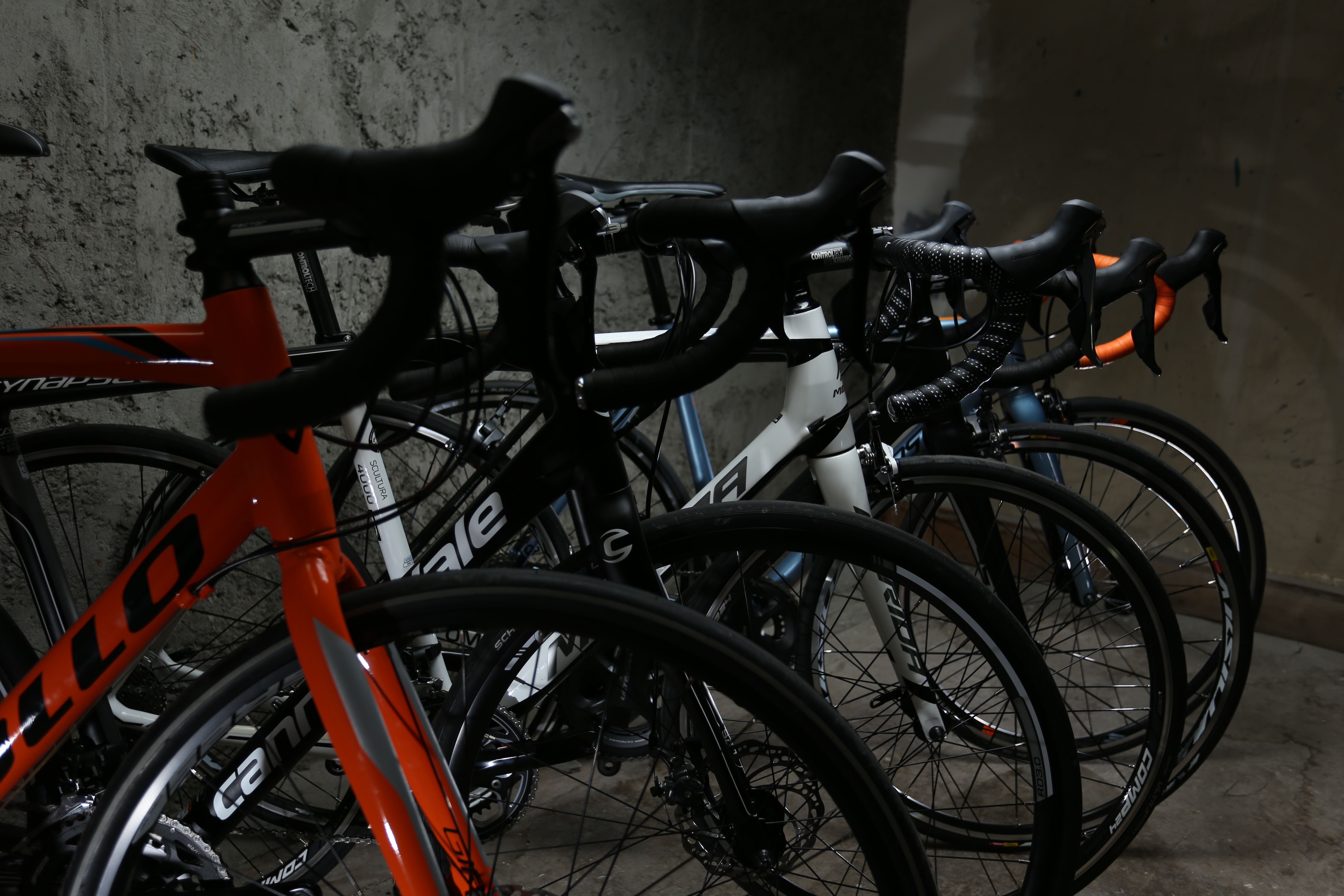
Really?
No mention of the cheapest of all of these?
Azzurri/Verite. (An Aussie brand)
And only ONE Aussie brand – Apollo (good on THEM by the way)
Poor form Bicycle Network.
Ooops, sorry Cell – Two Aussie brands.
Hi Peter,
We’ve previously reviewed an Azzurri Forza (admittedly different groupset, but same frame), so rather than review the same again, we thought it made better sense to present a variety of different bikes this time. That’s not to say that Azzurri don’t offer great value for money, but we do try to seek out new content rather than rehashing old reviews.
Perhaps a link to the older review then?
Re the Merida:
110mm BCD 5 bolt chainrings are as common as dirt, 34 up to 53. There whole lot of them out there, Shimano and aftermarket.
Such a basic mistake – do you really know much about components, enough to be reviewing them?
Veloaficionado, you should be in the diplomatic core.
Someone once said “To err is human” .
Write an article and show us how it is done.
By the way your second sentence would fail the grammar test.
“Diplomatic corps” correcting grammar….good luck with that one!!
Azzurri an Aussie brand?! Don’t they come direct from China / Taiwan now (i.e. no local warehouse, staff or showroom anymore) ?
Why isn’t the 2015 Giant Defy 1 here??? I just bought that bike for this year and it looks absolutely beautiful!!! and feels nice too!
We asked, but they were out of stock and couldn’t get one to us for this review.
Avanti Giro?
I am a novice rider and a new reader here. Just wanted to say whatever the differences in point of views or preferences amongst the authors and readers, I am already loving the magazine….
The Cell Omeo 1.0 would certainly be my pick under $2,000, but it seems Cell have decided to up the price to $2,300. See http://www.cellbikes.com.au/Cell-Omeo-1-0
Still a good price for the Ultegra gearing, but has lost the winning edge with the price-hike.
Good review but would of used the heading, “Reasonably priced commuting roadies”. I am currently looking for a road bike to ride to work; a daily bike that I can use, etc. These bikes I would have a look at for sure, but I would not do distance on a ride on Sat/Sun morning.
I got a 2014 cannondale synapse 105 disc about a year as my entry into road biking and commuting on a roadie. Came across from mountain biking so disc brakes appealed and wanted to ride in wet conditions. Bike has been great , always felt comfortable even on longer distances. Am now at stage of finding it a bit heavy and mechanical disc brakes could be better so looking to upgrade. Anyone have any suggestions. Another synapse just a lighter one?
I would look at a Malvern Star Oppy S2!.